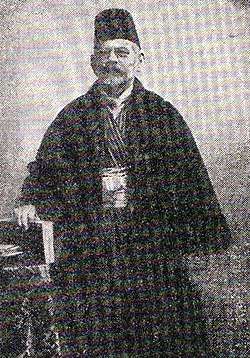Moshe ben Rafael Attias
Moshe ben Rafael Attias, also known as Moshe Rafajlović and Zeki Effendi (Sarajevo, 1845 – 2 July 1916), was a Bosnian Jew who became a scholar of the Islamic faith and of medieval Persian literature.[1]

Born to a prominent family of Sarajevo Sephardi Jews in the late Ottoman times, he spent most of his active life during the Austro-Hungarian administration of Bosnia and Herzegovina (1878–1914).
Moshe Attias attended an Ottoman state school in Sarajevo – open to all confessions but mainly attended by Bosnian Muslims – and studied according to an Islamic curriculum. He then moved to Istanbul to perfect his studies on Islamic religion and culture. There he became a scholar of the 13th century Persian poet and mystic Muslih-uddin Sa'di, the author of "Gulistan". Attias may have even become a Jewish sufi. Attias got the title of effendi, a scholar of Islam, which is visible from the Latin inscription on his grave. He was known in his last years as "Zeki Effendi".[1]
He then returned to Sarajevo, where he joined the Ottoman civil service, working for the tax authorities. He remained in town as a financial advisor after the Austro-Hungarian takeover of the capital in 1878.[1]
He was the treasurer of the Sarajevo Jewish society La Benevolencija, for which he kept a correspondence with Angel Pulido in Madrid.[2]
Zeki Effendi used to write in standard Castilian Spanish language, rather than in the Judeo-Spanish (Ladino) usually used by Sarajevo Jews, but still using the Hebrew alphabet.[1]
The poet Abraham Aaron Capón commissioned him to write an authoritative history of the Bosnian Jews. Zeki Effendi published it in the short-lived Sarajevo Ladino periodical, La Alborada, under the pen name '‘el Amante de la Luz’ ("the light-lover") – a reference to his illuministic approach to historiography.[3] He published in 1901 "La historia de los judiós de Bosna" (History of the Bosnian Jews), or "Konsezos de nuestros viezos".[4] His most well-known historiographic piece concerns Rabbi Moshe Danon, "the rabbi of Stolac."[5]
In 1908 his voice was recorded by Julius Subak on his trip to Sarajevo with Abraham A. Cappon – the record is kept at the Vienna Phonogrammarchiv, together with a 1907 recording of one of his poems.[4]
In 1911 Zeki Effendi made a tour of the Balkans together with the renowned Spanish scholar of Sephardic balladry, Don Manuel Manrique de Lara, recording oral texts from the Sefardi culture of Bosnia-Herzegovina, Serbia and Kosovo.[1]
Zeki Effendi is buried in the Old Jewish Cemetery in Sarajevo. His gravestone contains inscriptions in three scripts: Latin, Hebrew, and Arabic. His gravestone is possibly the only Jewish gravestone in the world containing both the Hebrew and Arabic script.
References
- Stephen Schwartz, Balkan Dreams, Modern Realities; Sarajevo, Center of Sephardism, Forward.com, 15 August 2003
- Sefardiweb
- Julia Phillips Cohen, Sarah Abrevaya Stein, Sephardic Scholarly Worlds: Toward a Novel Geography of Modern Jewish History, Jewish Quarterly Review, Volume 100, Number 3, Summer 2010, pp. 349–384 (Article)
- Sefardiweb
- Centre for Islamic Pluralism, Gedenken an Muhamed Neziroviċ Archived 19 December 2016 at the Wayback Machine
Bibliography
- [EN] Phillips Cohen, Julia and Sarah Abrevaya Stein "Sephardic Scholarly Worlds: Towards a Novel Geography of Modern Jewish History" Jewish Quarterly Review 100.3 (Summer 2010), pp. 349–384.
- [ES] Liebl, Christian "Sefarad im Phonogrammarchiv: Cappon, Cantors and Canetti" in Michael Studemund-Halévy, Christian Liebl e Ivana Vucina Simóvic, eds. Sefarad an der Donau. La lengua y literatura de los sefardíes en tierras de los Habsburgo, Barcelona, Tirocinio, 2013, pp. 371–384.
- [EN] Liebl, Christian, "'Avíe úne vez...': Julius Subak, Max A. Luria and phonographic field research among Sephardic communities in the Balkans", in: Los sefardíes ante los retos del mundo contemporáneo: identidad y mentalidades, Paloma Díaz-Mas y María Sánchez Pérez (eds.), Madrid, CSIC, 2010, pp. 240–241.
- [ES] Romero, Elena, La creación literaria en lengua sefardí, Madrid, Mapfre, 1992, pp. 206.
- [HE] Gaon, Moshe David, Yehudé hamizra beerets Yisrael, 2 vols., Jerusalén, Azriel, 1937, p. 514.
- [ES] Pulido, Angel, Españoles sin patria y la raza sefardí, Madrid, Sucesores de Rivadeneyra, 1904, pp. 330–331.
- [SCB] Muhamed Nezirovic', '‘Historija Bosanskih Jevreja Mosˇe (Rafaela) Atijasa – Zeki Efendije,'’ Prilozi 29 (2000): 245–60